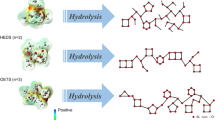Abstract
A novel poly(tetramethyl-1,3-silphenylenesiloxane) derivative having adamantyl moiety, i.e., poly(tetramethyl-5-adamantyl-1,3-silphenylenesiloxane) (P1) was synthesized by solution polycondensation of a novel disilanol monomer, i.e., 1-[3,5-(dimethylhydroxysilyl)phenyl]adamantane (M1). M1 was prepared by the Grignard reaction using chlorodimethylsilane and 1-(3,5-dibromophenyl)adamantane, followed by the hydrolysis catalyzed by 5% palladium on charcoal. P1 exhibited the good solubility in common organic solvents, such as tetrahydrofuran (THF), chloroform, dichloromethane, benzene, and toluene at ambient temperature. P1 was also soluble in hot hexane, diethyl ether, and ethyl acetate. The glass transition temperature (T g) and temperature at 5% weight loss (T d5) of P1 were 85 and 517 °C, respectively, and much higher than those of poly(tetramethyl-1,3-silphenylenesiloxane), indicating that P1 is a new polysiloxane derivative with good solubility as well as good thermostability.







Similar content being viewed by others
References
Fort RC Jr, Schleyer PR (1964) Adamantane: consequences of the diamondoid structure. Chem Rev 64:277–300
Malik AA, Archibald TG, Baum K, Unroe MR (1992) Thermally stable polymers based on acetylene-terminated adamantanes. J Polym Sci Part A Polym Chem 30:1747–1754
Pixton MR, Paul DR (1995) Gas transport properties of adamantane-based polysulfones. Polymer 36:3165–3172
Chern YT, Chung WH (1996) Preparation and properties of polyamides and polyimides derived from 1,3-diaminoadamantane. J Polym Sci Part A Polym Chem 34:117–124
Chern YT (1996) Preparation and properties of new polyimides derived from 1,6-diaminodiamantane. J Polym Sci Part A Polym Chem 34:125–131
Chern YT, Shiue HC (1997) Low dielectric constants of soluble polyimides based on adamantane. Macromolecules 30:4646–4651
Kameshima H, Nemoto N, Sanda F, Endo T (2002) Cationic ring-opening polymerization of five-membered cyclic thiocarbonate bearing an adamantane moiety via selective ring-opening direction. Macromolecules 35:5769–5773
Nemoto N, Ito Y, Endo T (2003) Cationic ring-opening polymerization behavior of a five-membered cyclic thiocarbonate having a spiro-linked adamantane moiety. J Polym Sci Part A Polym Chem 41:699–707
Liaw DJ, Huang CC, Chen WH (2006) Optically transparency and light color of novel highly organosoluble alicyclic polyimides with 4-tert-butylcyclohexyl group. Macromol Chem Phys 207:434–443
Hattori Y, Miyajima T, Sakai M, Nagase Y, Nemoto N (2008) Synthesis and thermal characterization of novel adamantane-based polysiloxane. Polymer 49:2825–2831
Matsumoto A, Tanaka S, Otsu T (1991) Synthesis and characterization of poly(1-adamantyl methacrylate): effects of the adamantyl group on radical polymerization kinetics and thermal properties of the polymer. Macromolecules 24:4017–4024
Chern YT (1996) Radical polymerization and antibacterial activity of copolymers based on N-1-adamantylmaleimide. Polym Bull 36:59–65
Jensen JJ, Grimsley M, Mathias LJ (1996) Adamantyl-substituted phenolic polymers. J Polym Sci Part A Polym Chem 34:397–402
Lewis CM, Mathias LJ (1997) Preliminary evaluation of polyesters with pendent adamantyl groups synthesized from 5-adamantylisophthalic acid and 1,4-butanediol. Polym Bull 39:15–20
Mathias LJ, Lewis CM, Wiegel KN (1997) Poly(ether ether ketone)s and poly(ether sulfones) with pendent adamantyl groups. Macromolecules 30:5970–5975
Ishizone T, Tajima H, Torimae H, Nakahama S (2002) Anionic polymerizations of 1-adamantyl methacrylate and 3-methacryloyloxy-1,1′-biadamantane. Macromol Chem Phys 202:2375–2384
Kobayashi S, Matsuzawa T, Matsuoka S, Tajima H, Ishizone T (2006) Living anionic polymerizations of 4-(1-adamantyl)styrene and 3-(4-vinylphenyl)-1,1′-biadamantane. Macromolecules 39:5979–5986
Seino H, Mochizuki A, Ueda M (1999) Synthesis of aliphatic polyimides containing adamantyl units. J Polym Sci Part A Polym Chem 37:3584–3590
Pasini D, Low E, Fréchet JMJ (2000) Novel design of carbon-rich polymers for 193 nm microlithography: adamantane-containing cyclopolymers. Adv Mater 12:347–350
Watanabe Y, Shibasaki Y, Ando S, Ueda M (2005) New negative-type photosensitive alkaline-developable semi-aromatic polyimides with low dielectric constants based on poly(amic acid) from aromatic diamine containing adamantyl units and alicyclic dianhydrides, a cross-linker, and a photoacid generator. Polym J 37:270–276
Mark JE (1990) Silicon-containing polymers. In: Ziegler JM, Gordon FW (eds) Silicon-based polymer science. American Chemical Society, Washington, DC (Adv Chem Ser, vol 224, pp 47–90)
Brook MA (2000) Silicon in organic, organometallic, and polymer chemistry (chapter 9). Wiley, New York
Choi KM, Rogers JA (2003) A photocurable poly(dimethylsiloxane) chemistry designed for soft lithographic molding and printing in the nanometer regime. J Am Chem Soc 125:4060–4061
Dvornic PR, Lenz RW (1990) High temperature siloxane elastomers (chapter 2). Hüthig & Wepf, Basel
Pai Y–M, Weber WP (1987) 1,3-Adamantanyl dimethylsiloxane copolymers: preparation and properties. Appl Organomet Chem 1:171–176
Otomo Y, Nagase Y, Nemoto N (2005) Synthesis and properties of novel poly(tetramethylsilnaphthylenesiloxane) derivatives. Polymer 46:9714–9724
Nemoto N, Watanabe Y, Umemiya J, Otomo Y (2006) Synthesis and characterization of poly(tetramethyl-1,4-silphenylenesiloxane) derivatives with oxyethylene substituent on phenylene moiety. Polym Bull 57:661–670
Sato I, Takeda S, Arai Y, Miwa H, Nagase Y, Nemoto N (2007) Synthesis and thermal characterization of novel poly(tetramethylsilanthrylenesiloxane) and poly(tetramethylsilphenanthrylenesiloxane) derivatives. Polym Bull 59:607–617
Niwa Y, Kouno S, Sayama W, Nemoto N (2008) Synthesis and thermal characterization of novel poly(tetramethyl-1,3-silphenylenesiloxane) derivative with phenol moiety in the main chain. J Polym Sci Part A Polym Chem 46:692–701
Zhang R, Pinhas AR, Mark JE (1997) Synthesis of poly(tetramethyl-m-silphenylenesiloxane), an elastomer of enhanced high-temperature stability. Macromolecules 30:2513–2515
Acknowledgments
This work was partly supported by 2008 Research Grant of College of Engineering, Nihon University. The authors would like to appreciate Dr. Chuichi Watanabe and Dr. Tetsuro Yuzawa, Frontier Laboratories Ltd., for the contribution in GC/MS analyses; and Ms. Satoko Tokiwa as well as Ms. Nami Sugashima, Nihon University College of Engineering Worldwide Research Center for Advanced Engineering and Technology (NEWCAT), for performing NMR measurements.
Author information
Authors and Affiliations
Corresponding author
Rights and permissions
About this article
Cite this article
Hattori, Y., Nemoto, N. Synthesis and thermal characterization of novel poly(tetramethyl-1,3-silphenylenesiloxane) derivative bearing adamantyl moiety. Polym. Bull. 63, 497–507 (2009). https://doi.org/10.1007/s00289-009-0110-7
Received:
Revised:
Accepted:
Published:
Issue Date:
DOI: https://doi.org/10.1007/s00289-009-0110-7




